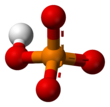Monohydrogen phosphate
 | |||
| |||
| Names | |||
|---|---|---|---|
| Preferred IUPAC name Hydrogenphosphate | |||
| Systematic IUPAC name Monohydrogenphosphate Phosphoric acid, ion(2-) | |||
| Other names Phosphoric acid, ion(2-) Hydrophosphoric acid (2-) Biphosphate (2-) | |||
| Identifiers | |||
CAS Number |
| ||
3D model (JSmol) |
| ||
| ChEBI |
| ||
| ChemSpider |
| ||
Gmelin Reference | 1998 | ||
PubChem CID |
| ||
| UNII |
| ||
CompTox Dashboard (EPA) |
| ||
InChI
| |||
| |||
| Properties | |||
Chemical formula | HPO2− 4 | ||
| Conjugate acid | Dihydrogen phosphate | ||
| Conjugate base | Phosphate | ||
Except where otherwise noted, data are given for materials in their standard state (at 25 °C [77 °F], 100 kPa). Infobox references | |||
Chemical compound
Hydrogen phosphate or monohydrogen phosphate (systematic name) is the inorganic ion with the formula [HPO4]2-. Its formula can also be written as [PO3(OH)]2-. Together with dihydrogen phosphate, hydrogenphosphate occurs widely in natural systems. Their salts are used in fertilizers and in cooking.[1] Most hydrogenphosphate salts are colorless, water soluble, and nontoxic.
It is a conjugate acid of phosphate [PO4]3- and a conjugate base of dihydrogen phosphate [H2PO4]−.
It is formed when a pyrophosphate anion [P
2O
7]4−
reacts with water H
2O by hydrolysis, which can give hydrogenphosphate:
- [P
2O
7]4−
+ H2O ⇌ 2 [HPO
4]2−
Acid-base equilibria
Hydrogenphosphate is an intermediate in the multistep conversion of phosphoric acid to phosphate:
| Equilibrium | Dissociation constant, pKa[2] |
|---|---|
| H3PO4 ⇌ H 2PO− 4 + H+ | pKa1 = 2.14[a] |
| H 2PO− 4 ⇌ HPO2− 4 + H+ | pKa2 = 7.20 |
| HPO2− 4 ⇌ PO3− 4 + H+ | pKa3 = 12.37 |
- ^ Values are at 25 °C and 0 ionic strength.
Examples
- Diammonium phosphate, (NH4)2HPO4
- Disodium phosphate, Na2HPO4, with varying amounts of water of hydration
References
- ^ Schrödter, Klaus; Bettermann, Gerhard; Staffel, Thomas; Wahl, Friedrich; Klein, Thomas; Hofmann, Thomas (2008). "Phosphoric Acid and Phosphates". Ullmann's Encyclopedia of Industrial Chemistry. Weinheim: Wiley-VCH. doi:10.1002/14356007.a19_465.pub3. ISBN 978-3527306732.
- ^ Powell, Kipton J.; Brown, Paul L.; Byrne, Robert H.; Gajda, Tamás; Hefter, Glenn; Sjöberg, Staffan; Wanner, Hans (2005). "Chemical speciation of environmentally significant heavy metals with inorganic ligands. Part 1: The Hg2+, Cl−, OH−, CO2−
3, SO2−
4, and PO3−
4 aqueous systems". Pure Appl. Chem. 77 (4): 739–800. doi:10.1351/pac200577040739.
- v
- t
- e
| H3PO4 [HPO4]2− [H2PO4]− | He | ||||||||||||||||||||
| Li3PO4 | Be | BPO4 +BO3 | C | (NH4)3PO4 (NH4)2HPO4 NH4H2PO4 -N | O | +F | Ne | ||||||||||||||
| Na3PO4 Na2HPO4 NaH2PO4 | Mg3(PO4)2 | AlPO4 | Si | P | +SO4 -S | Cl | Ar | ||||||||||||||
| K3PO4 K2HPO4 KH2PO4 | Ca3(PO4)2 | ScPO4 | Ti | VPO4 | CrPO4 | Mn3(PO4)2 MnPO4 | Fe3(PO4)2 FePO4 | Co3(PO4)2 | Ni3(PO4)2 | Cu3(PO4)2 | Zn3(PO4)2 | GaPO4 | Ge | As | -Se | Br | Kr | ||||
| Rb3PO4 | Sr3(PO4)2 | YPO4 | Zr3(PO4)4 | Nb | Mo | Tc | Ru | Rh | Pd | Ag3PO4 | Cd3(PO4)2 | InPO4 | Sn | SbPO4 -SbO4 | Te | I | Xe | ||||
| Cs3PO4 | Ba3(PO4)2 | * | LuPO4 | Hf | Ta | W | Re | Os | Ir | Pt | AuPO4 | Hg | Tl3PO4 | Pb3(PO4)2 | BiPO4 | Po | At | Rn | |||
| Fr | Ra | ** | Lr | Rf | Db | Sg | Bh | Hs | Mt | Ds | Rg | Cn | Nh | Fl | Mc | Lv | Ts | Og | |||
| * | LaPO4 | CePO4 | PrPO4 | NdPO4 | PmPO4 | SmPO4 | EuPO4 | GdPO4 | TbPO4 | DyPO4 | HoPO4 | ErPO4 | TmPO4 | YbPO4 | |||||||
| ** | AcPO4 | Th3(PO4)4 | Pa | U(PO4)2 | Np | PuPO4 | AmPO4 | CmPO4 | Bk | Cf | Es | Fm | Md | No | |||||||












